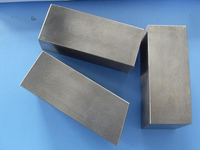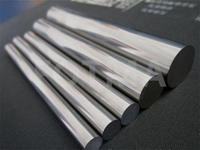Views: 19 Author: Site Editor Publish Time: 2019-06-17 Origin: Site
The use of molybdenum: the average content of molybdenum in the earth's crust is 0.00011%, and the global reserves of molybdenum resources are about 11 million tons. Molybdenum has the advantages of high strength, high melting point, corrosion resistance, wear resistance and the like, and is widely used in steel, petroleum, chemical, electrical and electronic technology, medicine and agriculture. At the same time, molybdenum is one of the essential trace elements that affect the normal growth of humans or plants. Molybdenum is mainly used in the steel industry, accounting for about 80% of the total consumption; followed by the chemical industry, accounting for about 10%; also used in electrical and electronic technology, medicine and agriculture, accounting for about 10% of total consumption.
1. World-class three molybdenum mine projects
In the domestic and international markets, the molybdenum concentrate industry is a highly concentrated industry. The top 11 companies in the world control 72% of the market supply, of which 5 are from China:
They are Shaanxi Jinduicheng Molybdenum Industry, Luoyang Molybdenum Industry, China Railway Yichun Luming Mining, China Gold Manchuria Wushan Mining, and Huaxia Jianlong Group Hebei Fengning Xinyuan Mining.
Large-scale mines that may be put into operation in the next five years include the Daxinganling Lulukou Molybdenum Mine in Heilongjiang and the Shapinggou Molybdenum Mine in Anhui Province.
01 Anhui Shapinggou Molybdenum Mine
After 2011, China newly discovered three 2 million-ton world-class molybdenum resources such as Shapinggou in Anhui.
The Shapinggou molybdenum mine belongs to the giant “porphyry” molybdenum deposit. The deposit is located in Jinzhai County, Lu'an City, Anhui Province, about 50 Km away from Jinzhai County. The Hefei-Wuhan high-speed railway and expressway pass through the southern part of the mining area.
The hardened pavement in the villages and villages will connect all the main residential areas into one, and connect with the county and township highways to form a transportation network extending in all directions, and the traffic is convenient.
According to the estimation of the exploration geological report of Shapinggou molybdenum deposit in Jinzhai County, Anhui Province (2013.3), the Shapingou molybdenum mine proved + control + inferential level (ie 331 + 332 + 333) ore reserves of 1,77,710,400 tons, molybdenum metal amount 2,459,413.82 Tons, the average grade is 0.139%.
It is currently the largest molybdenum deposit in Asia and the second largest in the world, and its molybdenum grade is also leading the world.
The molybdenum content in molybdenum ore (MoS2) in the ore accounts for 96.97-97.93% of the total molybdenum content. The laboratory test indicators are:
The molybdenum concentrate grade is 50.80%, 50.59%, the molybdenum recovery rate is 90.64%, 91.49%; the sulfur concentrate grade is 35.10%, 40.10%, the sulfur recovery rate is 65.46%, 59.21%, reaching the GB3200-89 molybdenum concentrate quality standard KMo49- A grade standard.
The Shapinggou molybdenum mine is easy to select and the associated sulfur can be comprehensively utilized. The main ore body thickness variation coefficient is 36%, and the industrial ore body thickness variation coefficient is 48%, which is a stable ore body.
02 Molybdenum Mine, Daxing'anling, Heilongjiang
Heilongjiang Daxing'anling Lulukou Molybdenum Mine is another giant molybdenum deposit discovered in China in recent years. The total construction investment is expected to exceed 10 billion yuan. It is owned by two private enterprises including Yunnan Chihong Zinc and Beijing Longdong Investment. Construction is expected to be put into trial production within 3 years.
The resources of the Kulukou mine are equivalent to those of Shapinggou, but the disadvantage is that the grade is too low, and the amount of resources with industrial development value is about 1.76 million tons.
The total resource of molybdenum ore is 2.46 million tons, including industrial mine (grade) 0.06%) 1.76 million tons, accounting for 72% of the total, the average grade is 0.087%; low grade ore (grade) 0.03%) 700,000 tons, accounting for the total 28%, average grade 0.048%.
The Institute has obtained some indicators of the China Railway Yichun Luming Mining from the public information, and compared it with the Shapinggou molybdenum mine in Anhui and the molybdenum mine in Daxing'anling, Heilongjiang. It can be seen that the Shapinggou molybdenum mine in Anhui is in Resource endowments, or geographical location, have certain comparative advantages.
The famous domestic molybdenum companies include Jinduicheng Molybdenum Co., Ltd., Luoyang Luanchuan Molybdenum Group Co., Ltd., China Railway Yichun Luming Mining, China Gold Manchuria Wushan Mining, Huaxia Jianlong Group, Hebei Fengning Xinyuan Mining, etc. .
Second, the distribution of molybdenum resources
01 Global distribution of molybdenum resources
At present, there are about 20 kinds of molybdenum ore discovered in the world, among which the most industrial value is molybdenum ore, followed by tungsten phase calcium ore, iron-platinum ore, color molybdenum-lead ore, and platinum-copper ore.
According to data released by the US Geological Survey in 2015, the global reserves of molybdenum resources are about 11 million tons. China is the world's most abundant molybdenum resource, with a reserve of 4.3 million tons of molybdenum resources, followed by the United States (2.7 million tons) and Chile. (1.8 million tons), the reserves of molybdenum resources in the three countries account for about 80% of the total global reserves.
Countries with rich molybdenum resources include Peru (450,000 tons), Canada (260,000 tons), Russia (250,000 tons), Australia (200,000 tons), Mongolia (160,000 tons), and Armenia (150,000 tons). Mexico (130,000 tons), Kazakhstan (130,000 tons), Kyrgyzstan (100,000 tons), Turkey (100,000 tons), Uzbekistan (60,000 tons) and Iran (50,000 tons).
02 China molybdenum resource distribution
China is one of the countries with the richest molybdenum resources in the world. According to the data released by the Ministry of Land and Resources, as of 2014, the proven reserves (metal content) of molybdenum mines in China reached 27.268 million tons.
In terms of the geographical distribution of molybdenum deposits in China, Zhongnan accounts for 35.7% of the country's total molybdenum reserves, 19.5% in the northeast, 13.9% in the northwest, 12% in the north, and only 4% in the southwest.
Henan Province has the largest number, accounting for 30.1% of the total reserves of molybdenum in the country, followed by Shaanxi Province accounting for 13.6% and Jilin Province accounting for 13%. The three provinces have 56.5% of the total molybdenum reserves.
In addition, the provinces (regions) with more reserves include: 6.7% in Shandong, 4% in Hebei, 3.7% in Liaoning, and 3.6% in Inner Mongolia. The total reserves of these 8 provinces (regions) accounted for 81.1% of the total reserves of molybdenum mines in China.
At present, the world's largest molybdenum mine is the Claymax Moss Mine in Colorado, USA, with a reserve of more than 3 million tons. The total reserves of the Luanchuan molybdenum mine in Henan is 2.06 million tons, ranking third in the world and second in Asia.
Compared with the world's major molybdenum resource countries such as the United States and Chile, the main feature of China's molybdenum mine is that there are many large deposits, but the grade is low. Low grade deposits with an average grade of less than 0.1% account for 65% of the total reserves, of which less than 0.05% account for 10%.
Medium grade (0.1% to 0.2%) deposits account for 30% of total reserves, grades with richer grades (0.2% to 0.3%) account for 4% of total reserves, while grades with grades greater than 0.3% account for only 1% of total reserves. .
Third, the development of molybdenum resources
Molybdenum is a rare metal, and its market size is much smaller than that of base metals such as iron and copper.
In 2016, the world's molybdenum concentrate production and consumption are close to equilibrium. The total amount is equivalent to 230,000 tons of molybdenum metal. According to the average international market price of $8.04/lb molybdenum in the past three years, the total market of molybdenum concentrate is about 4.077 billion. The US dollar is only about 4% of the global copper concentrate production and sales market in 2016.
Because the market capacity is small, a few large mines have a greater influence on the market. Therefore, it is easy to form a monopoly on the supply side. Regardless of the international market or the domestic market, most large-scale enterprises control most of the production capacity. The concentration of supply is high.
According to the annual output, the world's top 11 molybdenum mine enterprises can be divided into 4 levels. The US Freeport and the Chilean National Copper Company belong to the first level, with an annual output of more than 30,000 tons of molybdenum metal, Jinduicheng Molybdenum Industry, Luoyang Molybdenum. Industry and Luming Mining are all at the third level with an annual output of 1-2 million tons.
Since Jinduicheng Molybdenum Industry and Luoyang Molybdenum Industry have the molybdenum smelting and finishing capacity of the whole industrial chain, the molybdenum concentrate produced by its own mines is not sold to the public. In the domestic molybdenum concentrate trading market, China Railway Yichun Luming Mining is the only one. A mine with a production capacity of more than 10,000 tons controls 30% of the supply of molybdenum concentrate in the spot market, and its pricing has a benchmark effect on market prices.
01 Global molybdenum resource supply and demand situation
From a global perspective, China, the United States, and Chile are the major supply-producing countries. The total output of molybdenum in the three countries accounts for 80% of the global total. China accounts for about 35% of the total global production in 2016.
Among other producers in the world, Peru’s production has increased significantly in recent years. It is estimated that by 2020, South America will surpass China to become the world's largest producer and produce about 100,000 tons of metal.
From the overall pattern of global supply and demand, the molybdenum concentrate market from 2000 to 2008 basically maintained a balance between supply and demand.
However, there was an oversupply between 2008 and 2015. After the global financial crisis in 2008, the global economic situation continued to be sluggish. The demand for molybdenum-containing steel at home and abroad fell sharply. In addition, the new molybdenum mines at home and abroad were put into production, and the supply continued to rise. Excessive intensification, molybdenum ore prices have been falling.
By 2015, it had fallen to the lowest point of 680 yuan/ton in ten years, which is lower than the production cost of global molybdenum resources. However, with the reduction of production in foreign mines and some domestic mines in 2016, global supply and demand have returned to equilibrium.
Due to the long-term low-level operation of molybdenum, the proportion of low-cost by-product molybdenum in the molybdenum supply structure has been increasing, which has brought great pressure on the recovery of molybdenum prices.
In 2016, global crude steel output increased by 1% year-on-year, and stainless steel production increased by 7% year-on-year. The price of molybdenum, which is the raw material for petroleum pipes and 316 series stainless steel, decreased by 3% year-on-year.
From the perspective of terminal consumption of molybdenum, industries such as stainless steel and petroleum are the main sources of downstream demand. Demand for global molybdenum concentrates is concentrated in Europe, the United States and East Asia, with China's demand accounting for 36% of the total.
In the future, with the gradual recovery of the global economy and the restoration of the new normalization of China's economy, China's steel industry will enter the top oscillation period, and the supply and demand of global molybdenum concentrates will continue to rise slowly and balance. It is expected that 2020 will be molybdenum. Consumption will reach about 270,000 tons.
02 molybdenum ore price trend forecast
From the perspective of the price change of molybdenum ore, the price changes of China's molybdenum concentrates have been ups and downs in the past decade.
In the first half of 2005, the highest level could reach 6,150 yuan/ton; after that, the cliff type fell to around 4,000 yuan/ton;
In the second half of 2008, the molybdenum price fell again in a cliff-like decline until the second half of 2015, after 670 yuan/ton, it began to bottom out and reached 1060 yuan/ton by the end of 2016.
At the end of the first quarter of 2017, the price continued to recover upwards to 1,200 yuan / ton. Under the influence of multiple factors such as mine production increase, safety supervision and environmental inspection, the molybdenum price in China will be more frequent and the overall situation will be stable.
It is expected that the price of molybdenum concentrate will rise to 1,500 yuan/ton or more in 2017. The price will fluctuate in the mine cost line of 1,200 yuan/ton. In 2018, the price will increase to 1200-1400 yuan/ton. Degree interval.
After 2020, the price will either go out of the bottom space and run up, and try to break the rebalance point of 1700 yuan.
03 China's molybdenum resource development status
Since the reform and opening up, China's molybdenum industry has ushered in a peak of development. In 1995, China's molybdenum concentrate production increased from 10,000 tons in 1985 to 73,000 tons, and in 2008 it rose to 180,000 tons. In 2014, it reached an annual high of 202,000. Ton.
After that, due to the sluggish performance of the steel industry, the slowdown in demand for molybdenum and the oversupply of molybdenum led to a continued decline in molybdenum prices, which fell to 185,000 tons in 2016.
According to statistics, from 2007 to 2016, the average value of China's molybdenum concentrate production was 179,000 tons.
In recent years, the development of domestic molybdenum resources has shown a trend of increasing concentration. Large-scale high-quality mines are gradually controlled in the hands of a few enterprises, and their Chinese enterprises account for the vast majority.
In 2016, China has a certain scale of production mines of about 20, of which the top 5 companies account for 70% of the total output. )
Source: Minmetals Mining
In 2017, China's above-scale molybdenum mine enterprises will increase to about 25, and it is estimated that 19 new molybdenum mines will be added, with an estimated new production capacity of 36,000 tons.
4. Alternatives to primary molybdenum ore---Introduction to associated molybdenum ore and recovery of molybdenum
01 Associated Molybdenum Resources
The source of molybdenum concentrate is mainly divided into copper sulfide, tungsten and molybdenum and other associated molybdenum ore (MoS2). During the period of 2011-2015, due to the continuous decline of copper prices, some copper-molybdenum mines accelerated the implementation of associated molybdenum metal. Separation, accompanied by a significant increase in molybdenum production.
In 2016, the proportion of by-product molybdenum in molybdenum concentrate production has reached 62%. China's molybdenum ore is dominated by primary ore, while overseas mines are dominated by associated ore.
Associated ore mining costs are lower, but its grade is also low, generally not more than 0.1%; overseas crude ore grades are higher than domestic, such as Climax's US Henderson primary molybdenum grade of 0.24%.
The cash cost of foreign primary molybdenum ore is 6-7 US dollars per pound of molybdenum. For example, the cash cost of Henderson molybdenum ore is 5.6 US dollars per pound of molybdenum;
The world's sixth largest supplier, Thompson Creek Metals Canada, has a cash cost of $5.8-6.3 per pound of molybdenum; the cash cost of a major copper mine by-product molybdenum concentrate in South America is around $4 per pound of molybdenum.
The cost division of domestic enterprises is more serious, and large enterprises rely on economies of scale to control cash costs.
Compared with overseas mines, the cash cost of Luoyang Molybdenum Industry is about 3.6 US dollars per pound of molybdenum, and the cash cost of Jinduicheng Molybdenum Industry is about 3.3 US dollars per pound of molybdenum. The recovery rate of molybdenum metal is about 85%.
The cost of other small and medium-sized mines is relatively high, generally around 10 US dollars / pound of molybdenum.
02 Molybdenum recycling and utilization
With the continuous development of the molybdenum industry, the consumption of molybdenum raw materials is getting larger and larger, and the resources available for recycling are becoming less and less. In order to protect the environment and improve the utilization rate of molybdenum resources, developed countries have begun to pay attention to molybdenum renewable resources since the mid-1980s. , in particular, the use value of waste catalysts containing molybdenum.
For example, the molybdenum recovered from spent catalyst in the United States currently accounts for about one-third of its total supply.
The molybdenum content of molybdenum is generally higher than that of molybdenum ore. The cost of extracting molybdenum and other metals from it is lower than that of primary molybdenum ore, and requires less energy consumption and less exhaust emissions. The molybdenum recycling and utilization method is mainly based on the fire method, supplemented by the wet method.
At present, the recovery of molybdenum is mainly through the production of molybdenum-containing waste slag, waste liquid, etc. and molybdenum metal products produced in the molybdenum metallurgy process, and used molybdenum-containing chemicals or materials.
According to the report of the International Molybdenum Association, in 2011, nearly 80,000 tons of molybdenum was recycled worldwide, accounting for about a quarter of total molybdenum consumption. In 2020, the recovery of molybdenum will reach 110,000 tons, accounting for about 27% of total molybdenum supply. %, by 2030, this ratio will reach about 35%.
Of the recycled molybdenum resources, 60% are used to make stainless steel, and the rest are used in the manufacture of alloy tool steels, superalloys, high speed steels, cast steel and chemical catalysts.
The recovery of molybdenum has now become an important part of the supply of molybdenum resources. The recycling and utilization of molybdenum has become one of the focuses of the global molybdenum metal industry.
03 China's molybdenum recycling industry development
China's molybdenum recycling and utilization started relatively late, compared with the recovery rate and recycling grade of developed countries in Europe and America.





